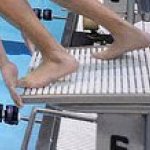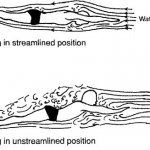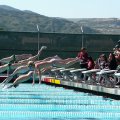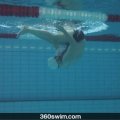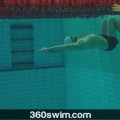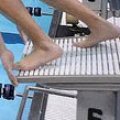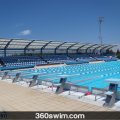HOW TO DIVE OFF A STARTING BLOCK: A BEGINNER'S PROGRESSION
In our last lesson, we covered the basics of the sitting dive and squatting dive. Now that you are comfortable with those, it's time to build on that foundation and move toward a proper start off the diving block.
This lesson will guide you through the next few progressions, from a standing dive at the poolside to your first dive from the block.
(Word of caution: perform these exercises only in a designated deep end of the pool where there is no risk of hitting the bottom.)
Dive Into: The Standing Dive Progression
- Step 1: The Assisted "Pseudo-Dive"
- Step 2: The Standing Dive from the Poolside
- Step 3: The Sitting Dive from the Block
- Step 4: The Standing Dive from the Block
- What's Next?
- Frequently Asked Questions
Step 1: The Assisted "Pseudo-Dive"
This drill requires a strong partner to help you feel the correct body angle without the fear of falling.
Start in a standing position at the edge of the pool with your toes curled over the side and your arms in a tight streamline. Have your partner stand beside you and hold you firmly by the hips.
Slowly lean your upper body forward over the water. Keep your head tightly tucked between your arms. Your partner will support your weight, allowing you to feel the downward "V" position of a proper dive. If you are not comfortable, just ask them to bring you back to the vertical position and try it again. When you are ready, your partner can gently let you go to complete the entry.
Step 2: The Standing Dive from the Poolside
This is the same as the drill above, but now you'll do it on your own.
Start in your streamline with your toes over the edge. Bend your knees slightly and start bending at your waist, bringing your fingertips down towards the water. When your fingertips are pointing about half a meter from the edge, start shifting your weight forward.
Let yourself fall into the water, entering fingertips-first. Remember the golden rule: keep your head tucked between your arms and look at your legs. Do not be tempted to look where you are going! If you look up, you will smack your chest into the water. Imagine your fingertips create a small hole in the water, and the rest of your body must follow through that same hole.
You can imagine that there is a floating ring on top of the water and your body needs to go through it without touching the sides.
If you are still unclear, just check the beautiful stickman below :).
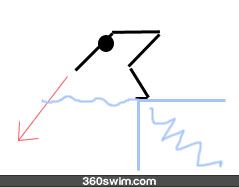
Step 3: The Sitting Dive from the Block
Now it's time to move to the starting block. In the same way we did the sitting dive from the side of the pool, we will do it from the block. This helps you get used to the increased height in a safe, controlled way.
I will repeat, the most important part is to keep your head between your arms. If you get scared and look up, you will likely do a painful belly flop. It's better to experience a small slap now; it will be a good reminder to keep your head down!
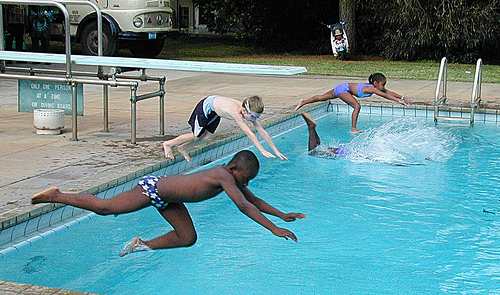
Step 4: The Standing Dive from the Block
When you've made it to this stage, you are ready for a basic start.
Get on the block and repeat the same process as the standing dive from the side: arms in streamline, feet together, toes over the edge. Bend your knees and waist until you are ready to shift your weight and fall in.
I will say it again: no matter what happens, KEEP YOUR HEAD BETWEEN YOUR ARMS.
If you have made it through a few belly flops to get this far, well done! You are tougher for it. If not, just keep practicing. You will get there.
If you find it difficult to do the above standing dive by yourself, you can have your friend help you. The basics are the same as the regular standing dive, except at the time you start to enter the water, your friend will cut your legs from underneath of you.
Instruct your buddy to stand next to you by the block and put his/her forearm in front of your ankles and when you are entering the water, he/she will simply help you move your legs upward with sweeping their forearm away from the pool toward your legs in a slightly upward motion. This will lift your legs up and give you a better angle of entry into the water.
What's Next?
If you have made it through numerous belly flops and faceplants all the way this far, very well done and you are tougher for it.
There is a bit more to a proper swimming start, like adding power and learning the track start, but this is for the next more advanced lesson. In the meantime, keep practicing and remember keep your head between your arms - do not look at the water.
Happy diving.
Frequently Asked Questions
I've mastered the sitting and squatting dive. What's the next step?
The next step is the standing dive from the side of the pool. This progression helps you get used to entering the water from a higher position while still focusing on the fundamental skill: keeping your head locked in a tight streamline.
What is the key to avoiding a painful belly flop when diving?
The number one rule is to keep your head tucked between your arms and your eyes looking back at your legs. Lifting your head to look forward is what causes your body to flatten out and slap the water. Enter the water like a spear, not a pancake.
How do I practice the feeling of a standing dive without letting go?
You can use a 'pseudo-dive' with a strong partner. Have them hold you by the hips as you lean forward into the dive position. This lets you feel the correct body angle without the fear of falling, and they can either guide you in or pull you back.
What is the most common mistake when diving for the first time?
The most common and instinctive mistake is lifting your head at the last second to see where you are going. You must fight this urge. Trust your streamline, keep your head tucked, and your dive will be much smoother and safer.
Should I dive into the shallow end of the pool?
Absolutely not. Always practice diving in a designated deep end where there is no risk of hitting the bottom. Safety is the top priority.
 LNURL1DP68GURN8GHJ7URP0YHRXD3SWDMKJMFWVDHK6TMVDE6HYMRS9A4HSCNCWFXSH3NN0H
LNURL1DP68GURN8GHJ7URP0YHRXD3SWDMKJMFWVDHK6TMVDE6HYMRS9A4HSCNCWFXSH3NN0H



